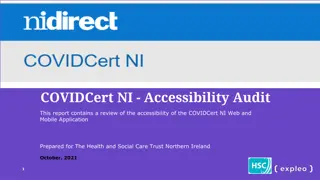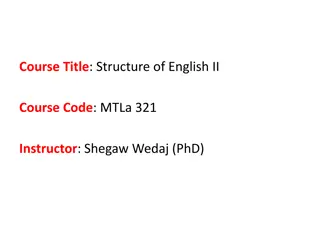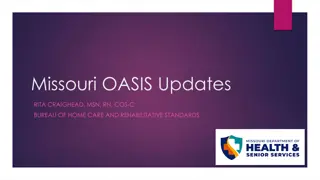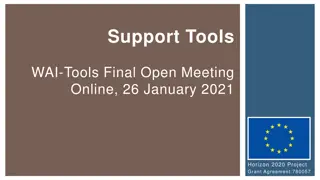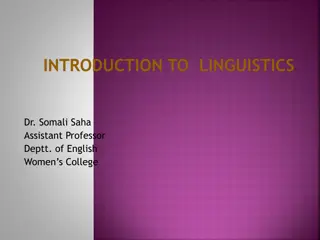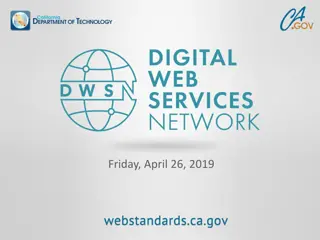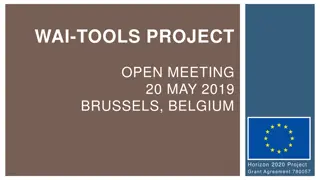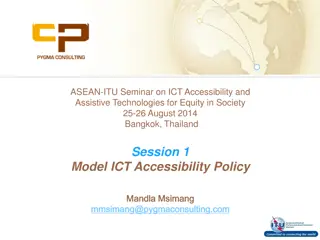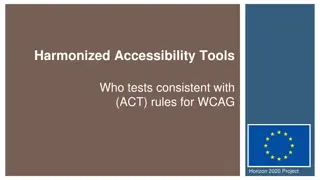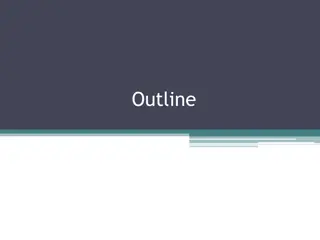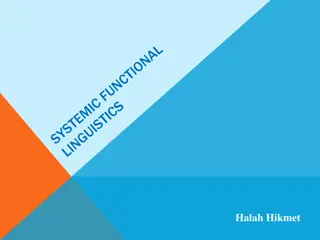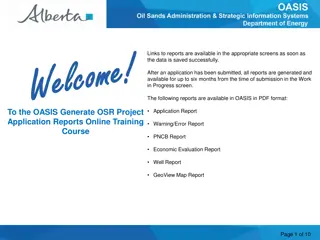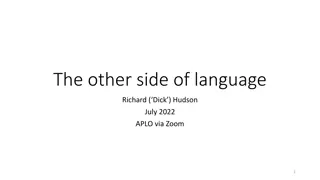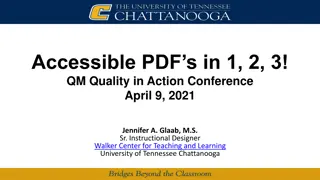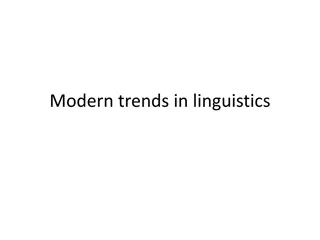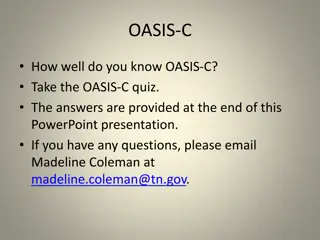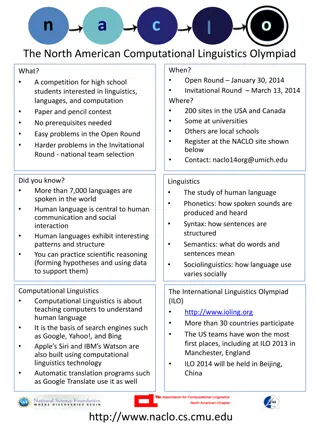Enhancing Accessibility in Applied Linguistics Research through OASIS
Establishing OASIS, a platform providing non-technical summaries of research articles in applied linguistics to bridge the gap between academia and stakeholders. OASIS aims to make research findings easily accessible and understandable to a wider audience, promoting engagement and knowledge dissemination.
Download Presentation

Please find below an Image/Link to download the presentation.
The content on the website is provided AS IS for your information and personal use only. It may not be sold, licensed, or shared on other websites without obtaining consent from the author.If you encounter any issues during the download, it is possible that the publisher has removed the file from their server.
You are allowed to download the files provided on this website for personal or commercial use, subject to the condition that they are used lawfully. All files are the property of their respective owners.
The content on the website is provided AS IS for your information and personal use only. It may not be sold, licensed, or shared on other websites without obtaining consent from the author.
E N D
Presentation Transcript
Extending the reach of research Establishing and sustaining a culture of accessible summaries of applied linguistics research Marsden, Andringa, Collins, Jackson, Kasprowicz, Perrin, Plonsky, BAAL, York St. John September 2018
What is OASIS? https://oasis-database.org/ One page, non-technical summaries of journal articles wide range (areas, theories, methods etc.) searchable interface accessed via international professional associations free author written or author approved Launched by short project; sustained by academic journals sustainable, systematic, international, peer-reviewed research
What this study was about and why it is important Single side A4 Times new roman What the researchers did who, what, how = contextualize Font size 11 What the researchers found Things to consider Limitations Relevance to own context?
Not creating great expectations about what Not creating great expectations about what research can tell us research can tell us (Lightbown, 1985) summaries stick to one study they are summaries; NOT applications & implications it s one step engagement among users needed cannot make all research accessible to all audiences
What problems does it solve? Research shows findings about language learning and teaching do no reach stakeholders easily academic publications are increasingly more difficult to read and understood by people outside the field
Why OASIS is important: 7 motivations Why OASIS is important: 7 motivations 1) Epistemic responsibility: Scientists must learn to communicate with the public, be willing to do so, and indeed consider it their duty to do so (The Bodmer Report, 1985) Impact Open science movement & social equity
Why OASIS is important: 7 motivations Why OASIS is important: 7 motivations 2) Our work is inaccessible The readability of scientific texts is decreasing over time (Plaven-Sigray et al. 2017) Average academic article read in its entirety by about 10 people (Goldacre 2014) Prof, no one is reading you .
Why OASIS is important: 7 motivations Why OASIS is important: 7 motivations 3) We cannot leave this to intermediaries: Professional journals do not cite scientific journals heavily or reliably (Marsden & Kasprowicz 2017) There are many initiatives, but most are: not sustained or of little relevance to language learning
Do professional publications cite academic research? (Marsden & Kasprowicz, 2017, The Modern Language Journal) 29 SSCI journals state they publish research related to L2 education But do professional publications cite them? We checked references from 5 years of professional association publications: LLJ, NECTL Review, Babel, ALL publications = 284 professional publication articles, 8616 references
Do professional publications cite academic research? Just 12.4% of references were to the 29 journals who say they publish on language education 6 professional articles needed for an academic journal to be cited once Huge range: More than 1/3 had NO references to SSCI L2 journals In 3% of articles, over 50% of refs to SSCI L2 journals
Why OASIS is important: 7 motivations Why OASIS is important: 7 motivations 4) Who decides what is disseminated to wider audiences? Currently, decided by intermediaries, such as journalists Exaggeration in news and university press releases (Sumner et al. 2014) Collins & Ruivivar (2018) reviewed the press
Why OASIS is important: 7 motivations Why OASIS is important: 7 motivations 5) Benefits of engaging with research for educators enriches professional identify and reflection Bai, 2018; Borg, 2010; Furlong et al., 2014; Stenhouse, 1975; Winch, Oancea & Orchard, 2015 6) Benefits for engaging with practitioners for researchers makes me think about research differently, helps me draw connections between different theories and data sources, and helps me keep the bigger picture in focus, even when I'm engaged in basic research (which is the bulk of my work). (from Tokowicz & Warren 2018)
Why OASIS is important: 7 motivations Why OASIS is important: 7 motivations 7) We are told summaries would be useful How can research be made more accessible? Marsden & Kasprowicz (2017): 62% of suggestions = accessible summaries, online, via practitioner outlets Andringa & Van Beuningen (in preparation): replicated the findings for teachers of Dutch as additional language
Marsden & Kasprowicz 2017: Survey among FL educators in the UK Factors preventing engagement with research Rate the extent to which these factors prevent you from engaging with research. Lack of respect for research Different view of teaching / learning (24) Not relevant (19) Teaching experience is sufficient (18) Lack of interest (17) Time / funds / regulations (2 components) Access and understanding Lack of professional development (46) Lack of authority (43) Terminology (33) Unaware of resources (32) Unaware of what is research-based practice (30) Lack of time (85) Regulation/guidance at a local level (44) No funds to attend conferences (59) No funds to do research (57)
OASIS progress to date Established a clear and long-term need for OASIS Consultation with practitioners, teacher educators, policy-makers Data from Marsden & Kasprowicz (2017) & Andringa & Beuningen Previous literature Survey data collected by OASIS team Collaboration with professional associations ACTFL, ALL, CAL, FIPLV, schools, networks
Progress to date Established support from research community Consulted with 16 journal Editors, funded by The British Academy All Editors supportive Running trial with recent authors Aim to include summary writing as obligatory part of article writing Language Learning, ReCALL, The Modern Language Journal, Second Language Research, Studies in Second Language Acquisition, Language Awareness, Language Testing, Canadian Modern Language Review are making concrete steps to incorporate into routine procedures.
Progress to date Genre of Accessible Summary established Collaborating with: teachers & teacher educators (via surveys, interviews, workshops) with researchers and journal editors Guidance, Examples, Template
OASIS to date Critical mass of summaries of existing articles (until December 2018) Network of summary writers with academic supervisors Students/ post-docs Concordia, Essex, Georgetown, Michigan, Penn State, Reading, UCL, York Sent to original authors for approval CRITICAL Searchable and sustainable database developed (2018) Ontologies that satisfy both researchers and non-academics technical team at University of York OASIS team will be able to check summaries before public release 13 journals agreed to incorporate procedures ask authors to write summaries
Next few months Establish sustainable procedures in journals (by Spring 2019, AAAL) 13 agreed already Professional Development and engagement activities for users (by Spring 2019) Portals / links to OASIS from key user associations
What can we do? Associations: Collaboration with and endorsement of OASIS policy statement, e.g., Association X recommends that journals incorporate Accessible Summaries in their publication guidelines and procedures, encouraging or, ideally, requiring their authors to write Accessible Summaries that are made available on an international, searchable database The American Psychological Association and AAAL make such position statements / good practice guidance Disseminate news of OASIS to affiliate members and groups
Something more immediate you can do Please write a summary of a journal article! Article must be published or accepted by an academic journal We have 100 more to write before December 2018. Template & guidelines available: https://oasis-database.org Please contact oasis@oasis-database.org Want monthly alerts of new summaries? Send email to oasis@oasis-database.org with 'alerts' in subject line.
Acknowledgements OASIS team: Sible Andringa, Laura Collins, Carrie Jackson, Rowena Kasprowicz, Luke Plonsky Language education professional associations: Ali Moellner at ACTFL; Joel Gomez at CAL; Steven Fawkes and Annalise Gordon at ALL, UK; Terry Lamb, former president of FIPLV, the international umbrella organization for over 100 language associations; Ian Bauckham, UK teaching schools council and Association of School and College Leaders; UK Gvmt s Dept of Education, UK. Funders: The British Academy, The Economic and Social Research Council Post-docs : Lisa Maria-Muller, Inge Alferink, Elizabeth Bailey, Lais Borges, Abigail Parrish, David O Reilly, Fatma Said, Angela Tellier Academic colleagues overseeing summary writing: Claudine Bowyer-Crane, Aline Godfroid, Heather Marsden, Kevin McManus, Florence Myles, Andrea Revesz Technical & administrative team: University of York Digital Library, Frank Feng & Sebastian Pelucha; Sophie Thompson. 17 Journal Editors attending workshop to help push this forward: Marta Ant n (The Modern Language Journal); Alex Boulton (ReCALL); Carole Chappelle (Language Testing); Mirjam Hauck (Computer Assisted Language Learning); Dana Ferris (Journal of Second Language Writing); Sue Gass (Studies in Second Language Acquisition); John Levis (Journal of Second Language Pronunciation); Marta Gonz lez-Lloret and Lawrence Zhang (System); Murray Munro (Canadian Modern Language Review); Silvina Montrul (Second Language Research); Hossein Nassaji (Language Teaching Research); Luke Plonsky (Foreign Language Annals); Nicholas Subtirelu (TESOL Quarterly); Leila Ranta and Joanna White (Language Awareness); Pavel Trofimovich (Language Learning)
De Houwer, A., Bornstein, M. & Putnick, D. (2014). A bilingualmonolingual comparison of young children's vocabulary size: Evidence from comprehension and production. Applied Psycholinguistics 35 (6), 1189-1211. https://doi.org/10.1017/S0142716412000744 Summary format Who knows more words: bilingual or monolingual children? Why this research is important Many people are concerned about the language development of children growing up with two languages in the family. Such children have been thought to have a smaller vocabulary (fewer words) than monolingual children. This study investigated the development of vocabulary size an important indicator of language development by bilingual (Dutch and French) and monolingual children (Dutch only) at 13 and 20 months of age. Both comprehension (how many words children understand) and production (how many words they can say) was tested. While there were large differences in vocabulary size between individual children, the study found very few differences between the two groups of bilingual and monolingual children. The OASIS initiative aims to make findings from language related research available and accessible to anyone who might be interested through non-technical open summaries. What the researchers did They recruited participants from 61 middle-class families with a single child. 30 used Dutch at home (monolingual) from birth and 31 used Dutch and French at home (bilingual) from birth. In 14 of these, mothers spoke French with their child, while fathers spoke Dutch. In 16 families, this was reversed. In one bilingual family, both parents used both languages when speaking to their child. They asked mothers, fathers and third persons (e.g., grandmothers) to individually indicate children's word knowledge on standardized lists of vocabulary items. They did this twice, when the focus child was 13 and 20 months old. People were asked to mark whether the child understood a word that (s)he did not yet say (comprehension) or whether (s)he both understood and said it (production). For the 30 monolingual children, Dutch lists were completed; for the 31 bilingual children, Dutch and French lists were completed. In this document, two prototype summaries are presented and annotated to help authors write summaries for OASIS. What the researchers found According to what the parents reported: Both at 13 and later at 20 months, bilingual children understood and produced as many Dutch words as the monolinguals. At 13 months, for both groups, children could understand many Dutch words beyond those they could say. At 20 months, this was still true, but the comprehension-production gap had decreased in both groups. The researchers also looked at total knowledge (taking comprehension and production together). At 13 months, total knowledge of Dutch words was similar across groups. For total knowledge of Dutch at 20 months, the monolingual children knew more Dutch words than the bilingual children. At 13 months, when total knowledge of Dutch and French was considered, bilinguals knew 60% more words than monolinguals. When comprehension without production was considered, the difference was even larger, with bilinguals understanding 71% more words. Differences between the two groups were generally small. Instead, differences between individuals within the groups were generally large. For example, at 20 months, children in the monolingual group said between 19 and 531 words; children in the bilingual group said between 14 and 1234 words. The current OASIS summary format, the writing guidelinesis, and the recommendations made in this document are based on: Survey research with potential stakeholders Interviews and think-aloud studies with teachers Feedback from journal editors Feedback from interested colleagues Our experience with writing summaries Things to consider There were large differences between individuals in both groups, and few differences between the groups as a whole. From this it seems that growing up bilingually may not be the most decisive factor for vocabulary development. If in a bilingual situation a child s vocabulary development is late, it is important to consider explanations other than being bilingual (for instance, a child may have a hearing problem). This study showed that growing up bilingually does not necessarily slow vocabulary development and may in fact speed it up. The participating children were selected for their similarities in terms of age, family composition, age of first exposure to each language, and socio-economic background. More research is needed to find out if the present findings hold in different types of bilingual settings and with different types of language pairs. How to cite this summary: Andringa, S., Bailey, E., De Houwer, A., Marsden, E., Kasprowicz, R. (2018). Do bilingual or monolingual children have more vocabulary knowledge? OASIS Summary of De Houwer, Bornstein & Putnick (2014) in Applied Psycholinguistics. https://oasis-database.org
62% of suggestions from teachers in Marsden & Kasprowicz 2017suggested accessible summaries, online links, via practitioner outlets What is already available? Other fields: ELife provides summaries of content in over 50 journals Pyschology journals ask for highlights or significance statements L2: ACTFL Language Educator: very short summaries of articles from one journal (FLA) Foreign Language Annals and Language Testing: invite authors to do podcasts Plonsky s Blogspot: students wrote summaries for a blog http://www.eltresearchbites.com/: anyone can submit a summary General Education: UKEd Blogs Summaries of research on children: http://www.bitescience.com/Default.aspx Government funded initiatives to synthesise or engage teachers in DOING research Research for Teachers: database of research summaries Research Bites: 2 minute presentations summarising key research findings DfES Best Practice Research Scholarships (2001)
Numbers Total of 152 summaries online



